Nænia Cornubiæ by William Borlase
Nænia Cornubiæ by William Borlase is in Prehistory.
Nænia Cornubiæ, A Descriptive Essay, Illustrative Of The Sepulchres And Funereal Customs Of The Early Inhabitants Of The County Of Cornwall. "Sunt * * Quorum Non Est Recordatio, Qui Perierunt Quasi Non Extitissent, Et Fuerunt Quasi Non Fuissent, Liberique Ipsorum Post Ipsos." Ecclus, Cap. Li.
by William Copeland Borlase, B.A., F.S.A. 1872.
To John Jope Rogers, Esq., Of Penrose, In The County Of Cornwall, President Of The Royal Institution Of Cornwall During The Years L868 And 1869, The Author Dedicates This Little Work; An Inadequate, Though A Grateful, Acknowledgement Of The Kind Interest He Has Always Taken In The Pursuits Of A Young Antiquary.
Books, Prehistory, Nænia Cornubiæ by William Borlase Introductory Preface
It is not without great deference that the Author presents his readers with the following notices of the Primitive Sepulchral Monuments of his native county. Living in the midst of these remains, and possessing, through the kind courtesy of the landed proprietors, every facility for extending his researches to those tumuli previously unexplored, he has amused himself by collecting together the materials from which these pages are now compiled. But when comparing the small amount of inductive evidence he has thus far been able to obtain, with the exhaustive compendium of facts brought by Mr. Bateman from the barrows of Derbyshire and Yorkshire, or with the extensive researches of Sir R. C. Hoare, and others who have devoted themselves to the task of solving the mystery of the burial mounds, each in his own district, he cannot but feel that his work, when he has done all, must be, at best, but brief and deficient. If, however, it will aid in the work of classifying the entire series of sepulchral remains, scattered throughout the British Isles, the first object will at least be gained; and, much more will this be the case, should the perusal of it lead others to follow in the track, and preserve from oblivion those relics of a "speechless past," which are daily falling a prey to the pickaxe or the plough.
In the minute and somewhat lengthy details which accompany some of the descriptions, the ordinary reader will find a considerable trial of his patience. But the Critic and the Antiquary will know how to pardon this fault, when they reflect that it is only by the accumulation and juxtaposition of such apparently worthless minutiae, that any one single fact can possibly be obtained, illustrative of the rude funereal customs practised in what may fairly be called the darkest age.
Many causes have been at work in Cornwall to make the task of gaining any detailed accounts of barrows previously searched one of peculiar difficulty; and the student must rely chiefly on such observations as he can himself personally make in the case of the few that still seem untouched. Until the last few years, very few persons, even of the better class, dreamed of preserving their discoveries at all: much less did they deem them worthy of a written account. Thus it has happened that out of the many thousand barrows strewn over the wilder portions of the Duchy, more than one half have been opened, as a mere matter of curiosity, by persons leaving no record whatever of the result. In other cases, where urns have actually been preserved and deposited in one of the two local Museums, the descriptions accompanying them are totally insufficient, and in a few instances are even mislaid and lost. Added to all this, the recent reclamation of waste-lands, particularly in the Western district, and the ever-fluctuating mineral interests, which literally turn the surface of the country inside out for miles together, have combined to obliterate those traces of the ancient inhabitants, which, when duly recorded and fitted together like a Chinese puzzle, make up the sum total of all that can ever be known about them. Yet, heavy as the "hand of ruin" has been laid on them, many a relic still remains to attest the fact that in the days of old, men were dwelling where we dwell, driving their flocks to pasture in the morning and -in the evening to their pens, warring with the enemy or weeping over the slain. And thus, on those same wild granite hills, where in the winter time the sportsman may delight himself in the destruction of the living, the antiquary during many a long summer s day may engage himself, perhaps almost as pleasurably, in the resuscitation of the dead; clothing, where he can, in the mantle of history, those memorials of the past, which accident or previous acquaintance with them may have thrown in his path.
In the course of the following essay, it must be understood that no monuments are mentioned, unless incidentally, but those in which either interments have actually occurred, or where a sepulchral origin is placed beyond doubt by their form, or by a comparison with similar remains in the same or a kindred district. The objects engraved are also, almost invariably, those discovered in close proximity to the interments. Barrows and Cairns, however, are by no means the most fruitful field for Cornish Antiquities.1 Tin stream-works, and the sites of ancient mines and smelting-houses, have been always the most productive source of objects of interest to the Cornish Antiquary; and a paper of considerable length and no little interest might be written on the subject of the implements, weapons, and ornaments of the ancient miners of the West.2 With these, however, the present treatise has nothing to do; and it will be sufficient at present for the reader to discover that the promise held out by the title of this little volume has been very incompletely fulfilled. Of this the author is well aware. Much remains to be done; nooks and corners in the county there are, which still require investigation; but, should these pages meet with the reader's approbation, the author of them can only add that he intends to continue his researches, and to embody in a second series, not only the unpublished accounts of several other barrows already explored by him, but also the details of any more, which he may be so fortunate as to obtain permission to investigate.
Note 1. Two gold lunulæ were, indeed, found in a mound of earth near Padstow, but not in connection with any sepulchral remains. The only instance where that precious metal has occurred actually with human bones will be duly described in the sequel.
Note 2. Carew mentions that in the stream-works are found "little tools heads of brass, which some term thunder axes." Besides these celts, bronze spear-heads, arrow-heads, ornaments of gold, and jet, &c., &c. are among the objects not unfrequently dug up in the "old men's workings."
And here he must record his best thanks to those who have already granted him leave to make researches on their lands. In every instance, to apply for has only been to obtain, in the kindest of terms, an unqualified permission.
The deep obligations he is under to those who have preceded him in the work of publishing the accounts of investigations in the Cornish tumuli will be duly acknowledged in their proper place. From their works and papers much valuable matter has necessarily been borrowed, in order to make the essay at all complete.
To John Evans, Esq., F.R.S., to Sir Edward Smirke, and to the Society of Antiquaries, the author is indebted for permission to reproduce drawings from their works; while to the Rev. Canon Greenwell, of Durham, F.S.A., and to Albert Way, Esq., F.S.A., he must express his especial thanks for their goodness in replying to several troublesome Antiquarian queries.
To the labours of Mr. J. T. Blight, F.S.A., he owes a considerable debt of gratitude; nor must he forget to bear testimony to the excellent manner in which his brother, Mr. Joseph Blight, has carried out the important share of the work (viz., the wood engravings,) allotted to him.
Some apology is due to the reader for the "errata." These have been caused by the fact, that the author was travelling about at the time when the proof was passing through his hands, and therefore could not always give it the undivided attention he should have wished.
Books, Prehistory, Nænia Cornubiæ by William Borlase Contents
Contents And Plan Of The Essay.
The Study of Archaeology its aim and tendencies remarks on the applicability of the theory of the 'Ages' to Cornish sepulchral interments the Druids
Primitive Sepulchres THE DOLMEN OR CROMLECH The Cromlech divided into three classes, viz: (a) The Cromlech proper (b) The larger Kist-Vaen (c) The open Kist-Vaen, or Cenotaph
The Cromlech proper Instance of at Lanyon Earth-cut grave found under
Interments divided into three classes, viz: (i) Extended Inhumation, (2) Contracted Inhumation, and (3) Cremation
Extended Inhumation, Instances Of, Extremely Rare
Earth-cut graves Trewren, Trigganeris
Caerwynen, the second example of a Cromlech proper
(b) The larger Kist-Vaen origin of contained inhumated interments; and, where long and narrow, in all probability extended interments
Pawton Cromlech
Stone graves at Samson at the Land's End at Botrea at Bosavern at the Cheesewring and at Godolphin
Larger Kist-Vaens in which the mode of primary interment is doubtful Lower Lanyon Trethevy Zennor Chywoone Mulfra Quoit, St. Columb Bosporthennis
Chambered Tumuli compared with the Swedish examples Giants' graves at Scilly at Treryn at Chapel Euny
II. CONTRACTED INHUMATION, instances of, also excessively rare doubtful examples Morvah Hill Maen, in Sennen Lesnewth
The Trevelgue Tumuli
III. CREMATION Origin and relative age of the custom the most usual mode of interment in Cornwall
The Menhirion, examples of in Cornwall sometimes tomb stones over burnt interments e.g., Pridden - Longstone - Trelew - Longstone - Trenuggo - Longstone - Tresvenneck - Longstone
Tregiffian Barrow and Longstone
Of the various kinds of Tttmuli met with in Cornwall Cone-shaped Barrows - Bowl Barrows - Bell Barrows - Flat Barrows - Ring Barrows
Circles, divided into two classes, (a) of erect stones, e.g. Tregaseal, &c., &c., whose sepulchral origin is doubtful (b) of contiguous stones, which latter are the Ring Barrows e.g. , Goonorman Botrea Trescaw and Wendron
Remarks on the selection of a spot for the burial the ceremony of the interment and the subsequent formation of the Barrow
Barrow on Trewavas Head
Remarks on the deposition of articles with the dead, and the practice of slave-killing
The Fictilia Of The Tumuli Divided Into Three Classes Vase-Shaped Urns Cylindrical Urns And Miniature Urns
EXPLORATIONS AND DISCOVERIES IN THE TUMULI - The 'One- Barrow' - Barrows at Lanyon - Veryan Beacon - Samson, Scilly - Withiel - Trelowarren - Chikarn - Bosavern - Ros - Gwythian - Durval - Trewinard - Kerris - Goldvadnek - Karnmenelez - Perran Sands - St. Mary's, Scilly - Karn, Morvah - Miscellaneous - St. Austell Downs - Pelynt - Newquay - Glen Dorgal - Trevelgue - Cliff-Castle - Place - Gerrans - Portscatha - Trevello - Karn - Trannack - Conquer Downs - Brane Common - Boleit (with traditions of a batik field at) - Boscawen-ûn - Clahar Garden - Penquite - Sennen - Tredinney - Angrowse, 1st barrow at - 2nd ditto - Pradanack - Denzell Downs - Morvah-Hill
The Age Of The Monuments - Late Roman Coins Found In Cornwall - State Of The Country During The Romano-British Period - Hut-Circles Referable To This Period - The Tumuli Are The Sepulchres Of The Dwellers In The Huts - The Towednack Cromlech - Chywoone Cromlech - Notes On Flint Chips - Conclusion
Addenda. (A) Sepulchral Monuments In Meneage (B) Boskednan Circle And Barrow (C) Barrows Near Bosporthennis, Zennor
Books, Prehistory, Nænia Cornubiæ by William Borlase Lanyon Cromlech
This monument, as will be seen from the accompanying engraving taken from Borlase's Cornwall2, consisted, until its fall in the year 1815, of three slim pillars of unhewn granite, supporting on their summits a horizontal stone, at a sufficient height from the ground to permit a man mounted on horseback to sit under it. The cap stone, or "quoit," as it is termed in Cornwall, measured, (before a piece was broken off it), 47 feet in circumference, and averaged 20 inches thick. Viewed from the opposite hill, for it stands on high ground, the whole structure may not, even in its present stunted form1, be inaptly compared to a three-legged milking-stool. About the middle of the last century, a dream induced the owner of the property to dig beneath it, and directly under the "quoit" a simple grave was discovered, cut in the natural soil, without side stones or covering. At the depth of six feet the explorers reached the bottom; but unfortunately the other dimensions are not recorded. Although this pit was carefully searched on that occasion, and subsequently rifled more than once, Dr. Borlase assures us that nothing was found "more than ordinary." From this discovery, it seems quite clear that inhumation was the mode of burial practised in this case; for had cremation taken place, ashes, or at all events strata of burnt earth, would have been found; and it is only on the supposition that the corpse was laid unprotected in the porous ground, without any imperishable articles accompanying it, that the total absence of relics in the grave can be at all accounted for. Had the length of the cavity been recorded, some inference might have been formed as to the position in which the body was placed; that is whether it was extended at full length, or contracted, with the knees bent up towards the chin. Trivial as such a distinction may at first sight appear, it is just one of those points which, if carefully followed up, may one day become valuable to the ethnologist in distinguishing the lines of demarcation to be drawn between the various races or tribes inhabiting this country in the primitive era.
Note 2. The accuracy of the dimensions given in Borlase is fully borne out by a drawing of the same monument made by the late Canon Rogers, in 1797, eighteen years before its fall.
Note 1a. It was set up again in 1824, but several of the stones had been broken, and one of the supporters bears marks of recent cleavage. At present a person must stoop to pass under it.
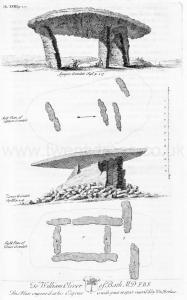
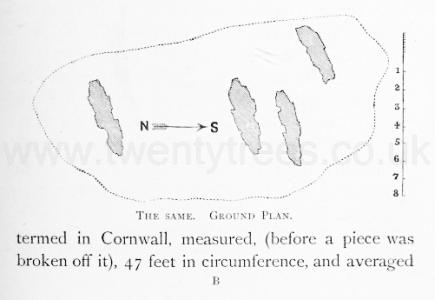
The different modes of disposing of the body, which meet the explorers of the early sarcophagi of Great Britain, are three in number. Interments have either been placed in the ground whole, or they have been reduced to ashes by (i) cremation. Those bodies which have been buried in their entirety are either (2) extended or (3) contracted. Leaving the subject of cremation for a future page, it may be remarked with reference to the practice of inhumation, that throughout the North of England it is by far the most common mode of burial; and that in England generally the contracted form of it has been found to have prevailed very largely over the extended. Thus the Rev. Canon Greenwell, in a letter dated the 12th of December, 1871, informs the author that "out of above 200 interments of what may be considered pre-Roman times," he has only found "a single instance where the body had been buried in an extended position." So much for the North.
Coming further South the combined researches of Sir R. C. Hoare and Thomas Bateman, Esq., tabulated by Sir John Lubbock, show that out of some 500 interments explored with care, only thirty-seven were extended, while 112 were contracted, the rest being burnt.
In Cornwall a marked difference is observable. Well authenticated instances of inhumation at all are extremely rare. Among these, only two or three examples of the extended position actually occur; but the not-uncommon occurrence of empty long graves, whether cut in the hard soil or walled with stones, affords a strong presumption that, had they not been rifled, a similar mode of interment might have been discovered in them. Of the contracted position, as will be seen hereafter, only one really authentic instance can be cited.
As to the relative ages of these two modes of sepulture, it would be hard to make even an approximate guess. Dr. Fergusson, speaks of Canon Greenwell's contracted discoveries as "really pre-historic," and he is probably right. But a pre-disposition, in favor of the simplicity and appropriateness of our present custom, has led many to the conclusion that the extended mode would more naturally have suggested itself to man in the earliest stages of civilized life. Should this latter notion be adopted, it must not be overlooked that the return to the primitive custom, in Christian times, must always induce the doubt whether graves of this description may not belong to a much more recent period.
As in the case of Lanyon, an empty earth-cut grave has been mentioned in connection with megalithic remains, it may not be amiss, before passing on to describe a second "tripod" Cromlech, to notice two other instances where a similar grave has been found. In each of these cases, the monument has consisted of two pillars of unhewn granite placed at no great distance apart. Graves adorned in this manner are the common property of all ages and all religions. Their history was just as much out of remembrance in the days of Homer, as it is now:
[Greek Text]1
Note 1. Homer's Iliad, lib. xxiii, 329. Mr. Wright translates the pasage: "On either side rise two white stones set there To mark the tomb of some one long since dead."
A sketch in the "Univers Pittoresque" of two rude stones in Corsica, might serve as an adequate representation of the Cornish specimens; and the Giant's Grave at Penrith Churchyard, in Cumberland2, is doubtless one of the earliest instances of the gradual introduction of the head-stone and foot stone so commonly set up by Christian1a mourners of the present day.
Note 2. Higgins' Celtic Druids, p. 148.
Note 1a. "The Monk, O'Gorgon, is buried near to the Chapel, and there is a Stone five Foot high at each End of this Grave." Martin, Isles of Skie, p. 167.
Two monuments of this kind are extant in Cornwall. They are situated within a mile or two of each other, and of the Lanyon Cromlech [Map], and both have been explored, the first by Dr. Borlase in the year 1752, and the second by the author in 1871.
The former2 [Tolmen Stone [Map]] is situated in a field sloping towards the west, on the estate of Trewren, in the parish of Madron. The respective heights of the two rough pillars in this case are five and six feet above ground, and the distance between them ten feet. They point in a direction E. by N., and W. by S. "Upon searching the ground between these two stones the diggers presently found a pit six feet six long, two feet nine wide, and four feet six deep; near the bottom it was full of black greasy earth, but no bone to be seen. This grave came close to the Westernmost and largest stone, next to which, I imagine, the head of the interred lay. The Christians in some parts buried in this manner, but in compliance, as it is to be imagined, with a more ancient Pagan custom."3 The author of these pages was fortunate enough to be present some few years since, when this grave was re-opened by the late William Coulson, Esq., the owner of the land, when the above account was fully confirmed. The black soil in the grave is the peat natural to the country.
Note 2. See elevation and ground plan in Borlase's Antiquities, p. 146, pl. x.
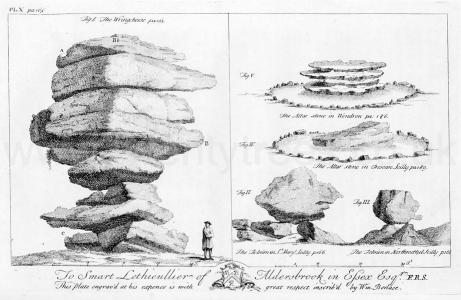
At Trigganeris, or Higher Drift, in the adjoining parish of Sancreed, there stands, on the top of the hill, another monument, evidently of the same description as the last. It consists, as in the former case, of a taller and a shorter pillar, the former nine feet in height, the latter seven feet four inches. The direction in which they lie is NNW. and SSE. During the excavation of a trench between these stones the author came upon the end of a cavity cut with much precision in the hard natural clay, or, as the Cornish term it, "rabman." This proved to be a grave six feet long, three feet three broad, and about five deep, corresponding remarkably with the dimensions of that at T re wren. It lay, however, not lengthways between the pillars, but nearly at right angles to them, and completely out of the line, so that a tape stretched from the centre of the one to the centre of the other scarcely, if at all, passed through a corner of it. No flat stones were found in the grave, nor indeed anything but the fine disturbed sub-soil of the neighbourhood.1
Note 1. Canon Greenwell remarks that "empty graves are not uncommon, and that it depends upon surrounding circumstances, whether the bones have decayed or not," he having "found them in all stages of decay."
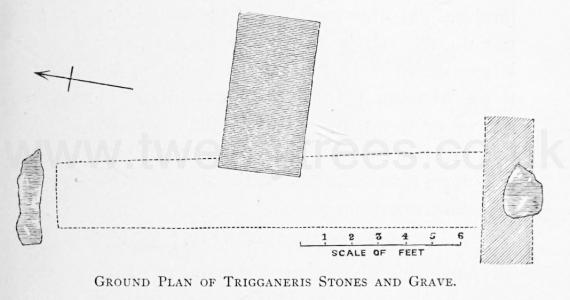
Remarkable as is the attempt at orientation in both these cases, and in the latter especially, (for the Trigganeris grave lies nearly due East and West) it must still be noticed that in no respect do these pillars differ in character from the rudest of the menhirs, and the other members of the megalithic family; nor do they show any traces of the patterns and letters which distinguished the tombs of the primitive Christians. No remains or traditions of chapelries or oratories are extant in their vicinity, and if they are indeed to be ascribed to Christians at all, they form a striking link in the sepulchral history of that dark uncertain period.
Books, Prehistory, Nænia Cornubiæ by William Borlase Caerwynen Cromlech
After this digression it remains to glance at the one other instance of a "Cromlech proper" which Cornwall affords; before passing on to the more extensive subject of the Kist Vaens. This monument [Carwynnen Quoit [Map]] is situated in the centre of a sloping meadow on a tenement called Caerwynen, immediately opposite the front windows of the old family mansion of Pendarves. Similar to Lanyon Cromlech in its construction, it has also shared its fate, for it fell many years since; but was, as a labourer asserted who had assisted in the work, soon after replaced by the patriotic lady of the manor, in much the same position as before. Fortunately a drawing of it, by Borlase, (larger than that in his published work), is extant in his MS. collections, from which the accompanying engravings are taken.
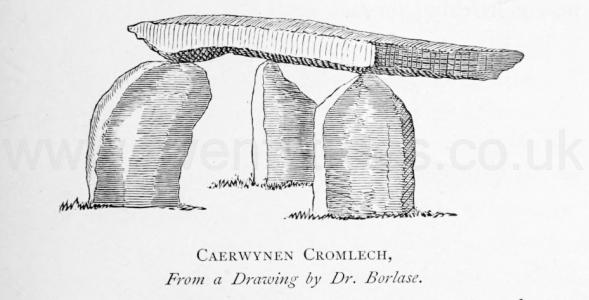
The two supporters at the south-eastern end seem to have retained their original positions. They were, formerly, respectively 5 feet i inch, and 5 feet 2 inches above ground, and are still nearly the same height. The single pillar at the other side has been moved nearer the edge of the covering stone than in the above sketch; it measured 4 feet 1 1 inches high, but is now shorter. The covering slab, which, like the other stones, is granite, measures twelve feet by nine; one side, however, seems to have been broken in its fall. Some stones now standing on the north side, were placed there subsequently to the restoration. No pit was sunk beneath it, nor has it ever been explored, and there are no remains of a tumulus under or around it. If explored, (which would be in its present state a dangerous operation), it is highly probable that a grave similar to that at Lanyon would be found, the area between the supporters being formerly seven feet long, by about five broad, though now something more.
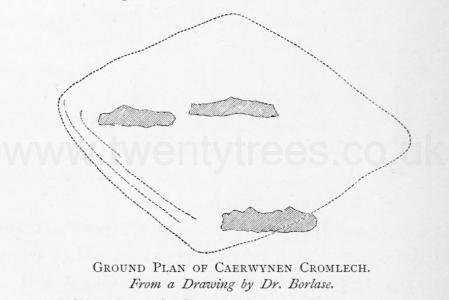
A fallen Cromlech which may have possibly belonged to the "tripod" class, is to be found near Helmen Tor, in the parish of Lanlivery. A drawing of this will be found in Blight's "Crosses of East Cornwall," p. 131.
The distinction between "the Cromlech proper," such as that just described, and the "Larger Kist Vaen" has been already noticed. In proceeding to consider this latter class it will be found that it comprises every other monument of the kind still extant in Cornwall.
The idea of building a habitation for the dead owes its origin to the most primitive times; and may be regarded as one of the earliest conceptions of the mind of man. It belongs to a state of society when death, considered as a total extinction or annihilation, was by no means fully realized;1 nor, on the other hand, had the future life yet been defined as a matter of certitude or religious contemplation. Thus, the four walls and roof rose around and covered the corpse, the five plain slabs presenting the most ready, as well as the most substantial model of the dwelling house, and affording the first requisite in domestic architecture, namely: protection from external adverse circumstances. Thus was formed the true "Beth" or "Bedd," the "Bod" or "Bos" of the Cornu-Britons; firstly, the home of the living, and secondly, the [Greek Text] the chamber of the dead. Not that any of our British Cromlechs have actually served the former purpose, like the Gangrabben of Scandinavia, or the hovels of those modern savages, who, on the death of the tenant, immediately convert his temporary holding into a fee-simple for ever by blocking up the entrance: but still, it is more than probable that the idea was the same throughout, and that the Kist Vaen was in its origin simply a contracted or miniature representation of the class of residence occupied by the deceased during life. This idea is supported in great measure by a comparison of the rude masonry displayed in these structures, (the extended or passage ones particularly), with that of the huts and underground chambers which so frequently occur in their immediate vicinity. It must, however, be observed that this style of architecture, if indeed it can be called such, belongs to nearly every inhabited district in the world; everywhere in fact, where slabs of granite or flag stones afford materials ready at hand for the execution of so simple a design. That edifices so constructed are of a most primitive type must at once be clear to all who are willing to admit that, in the absence of reliable evidence, simplicity of design only signifies priority of construction. The comparison between man in his primitive state and children who act by the light of nature alone, has been often made: and the author will only add, that on a Cornish goose green, in the midst of the hamlet or "town place," he has more than once watched the formation of a group of dolmens, which, if only magnified, would rival those of the Khasias, or any other tribe of dolmen-builders in ancient or modern times. Indeed, the masonry displayed in the Larger Kist Vaen is peculiarly characteristic of man in his primeval or infantine state; and thus it seems that, by using a term such as "dolmen-builders," we cannot draw a line round any particular century, nation, or locality. It was the sepulchre alike of the. early inhabitants of Malabar and of India, of Northern Africa, as well as of Western Europe, Denmark, Norway, and Sweden. Drawings and descriptions are continually brought home, of Cromlechs, which, with a very few characteristic differences, resemble so strangely those of Europe, that one might fancy they belonged not to any foreign clime, but to our own native hills. But while European writers are wondering at the universality of this mode of burial throughout so many widely distant countries of the globe, and are being startled by the fact that there are actually tribes in India who are erecting these very identical structures while they are writing and speculating, let them ask themselves the question, 'Are they so perfectly certain that they are not "dolmen-builders" themselves ?' May there not be those who can see, not only in the Altar-tomb of the Romans, or the sarcophagus of the Middle Ages, but in the square cenotaph of our modern churchyard, the lineal descendant of the Pagan Kist Vaen ? To make the chain complete, examples are not wanting of a transition period, which it would be most interesting to follow up. Many instances might be quoted of tombs of this class found in close proximity to early Christian edifices; and Dr. Petrie in especial has left us the record of one, at least, still standing near a ruined church in the island of Ardoilen. But to come to more recent times: Suppose for an instant that a native Khasian antiquary, (if such a fellow could be found), interested in the comparative ethnology of his race, were to visit Great Britain: Suppose him taken to a grave yard, say, in a slate district, where the square five-slab tombs abound, and would he not return to his native countrymen with the news that he had found a "group" of as genuine "dolmen-builders" as they themselves ? It seems, therefore, only fair to conclude, that this primitive dwelling of the dead, deriving its origin to all appearance from the latent superstition of the earliest ages, subsequently received, with the spread of civilization, the sanction of custom and the protection of religion; and that even in its pristine form it has not yet disappeared from among the number of those monuments which adorn, or too often disfigure, our modern English churchyards.
Note 1. In some of the Indian, and the Circassian dolmens, a hole is bored in one of the side-stones, supposed to be indented for the reception of food for the occupant of the tomb.
It may be laid down as a general rule, which recent investigation has made almost universal1, that all the larger Kist Vaens, or Cromlechs of the second class were designed to contain the remains of the deceased unburnt. Professor Nillson2, remarking on the dös, or Scandinavian Cromlech, says, that it was "erected in order to contain one body only, which was always placed in a sitting posture." This, however, is not so invariably the case in other countries. At De Tus, in Guernsey, for example, Mr. Lukis3 found two skeletons in the same kist, and a like number were taken from the Phcenix Park4 Cromlech, at Dublin. In both these cases the bodies were contracted; but that the extended mode of inhumation was never practised in the larger Kist Vaens is by no means certain; and, with regard to those which are now empty, it seems only reasonable to suppose, that where the chamber is sufficiently long to contain an extended interment, the body was placed in that position; while, in the cases where it is too small to admit of such being the case, a sitting, kneeling, or other contracted posture was resorted to. In Cornwall, the length of the Larger Kists averages from 10 feet to 6 feet; so that in each case a body might have been interred at full length. The one which will be first noticed, viz., that at Pawton, in the parish of St. Breock, seems more especially to point to this mode of sepulture.
Note 1. An exception to this rule, in the case of a Cornish Cromlech, will be found at page [?], but this may be a secondary interment.
Note 2. "Primitive Inhabitants of Scandinavia," translated by Sir John Lubbock, P. 159.
Note 3. Journal of the Archaeological Association, vol. I, p. 27.
Note 4. See Mr. Wakeman's admirable little "Handbook of Irish Antiquities," p. 9.
This monument [Pawton Quoit [Map]] is situated on high ground in the centre of a field immediately above the picturesque valley and ancient ecclesiastical establishment of Pawton.
The accompanying sketch, taken by the author a few months since, will, perhaps, convey some slight idea of the structure. The stones which form the grave are eight in number, but the covering stone itself rests on only three of them. They are still more than half buried in the tumulus which formerly, no doubt, covered the whole. This was of an oval shape, and upwards of sixty feet in length. The grave itself is seven feet long; and, but for a stone which has been inserted at one end, would be a foot and a half longer. This stone is probably a prop to support the one on which that end of the capstone rests. The width of the grave is two feet at one end, and three and a half at the other: it is at present five feet deep, though it may in all probability be several feet deeper. The sparry stone which forms the covering is thirteen feet in length, by seven in breadth; and, as a labourer informed me that a piece (marked A, in the accompanying plan,) had been broken off from it, the length may be increased by several feet. In thickness the covering stone is uniformly two feet six.
From the shape and size of the kist in this case, there can be no doubt that it was constructed to contain a body at full length; and although, as was before noticed, interments in that position are so very rare in other parts of England, there are other instances (though few and far between) of similar graves in Cornwall, to prove that this mode of burial was not by any means unknown in that district. In several cases the author has particularly noticed that the grave is too narrow to admit of the body being contracted at all, and in more than one case a skeleton 1 extended has actually been found. Two or three of these long walled graves may here be described.
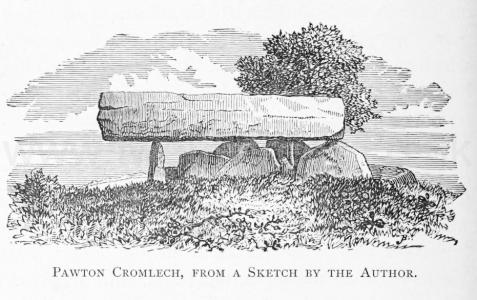
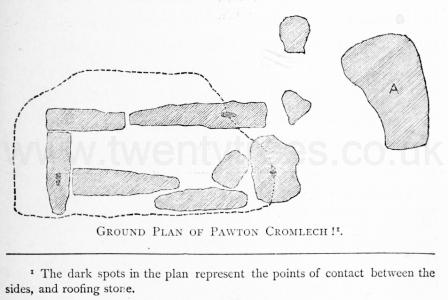
Books, Prehistory, Nænia Cornubiæ by William Borlase Lower Lanyon Cromlech
The monument referred to is, curiously enough, situated on the same estate as the one lately described, namely, at Lanyon, in the parish of Madron; and is quite as good a specimen of the "Kist" type, as the former one was of the "Cromlech proper."
Two stones are all that now remain, viz., the covering stone, and one of the supporters; the others having been split up and carried away for building. A very rough sketch of this Cromlech, when perfect, will be found in Mr. Cotton's Illustrations of Antiquities in Cornwall, page 37; and the following notice of its discovery is preserved in the Archæologia, Vol. xiv, page 228.
"The gentleman who owns the estate of Lanyon, happening to be overtaken by a shower of rain in walking through his fields, took shelter behind a bank of earth and stones, and remarking that the earth was rich, he thought it might be useful for a compost. Accordingly, he sent his servants soon after to carry it off, when, having removed near a hundred cart loads, they observed the supporters of a Cromleh, from which the coverstone was slipped off on the south side, but still leaning against them. These supporters include a rectangular space open only at the north end, their dimensions being of a very extraordinary size, viz., that forming the eastern side ten feet and a half long, that on the west nine feet, with a small one added to complete the length of the other side, and the stone shutting up the south end about five feet wide. The cover-stone is about thirteen feet and a half, by ten feet and a half." "As soon as the gentleman observed it to be a Cromleh, he ordered his men to dig under it, where they soon ound a broken urn with many ashes, and going deeper they took up about half of a skull, the thigh bones, and most of the other bones of a human body, lying in a promiscuous state, and in such a disordered manner as fully proved that the grave had been opened before; and this is the more certain, because the flat stones which formed the grave, or what Dr. Borlase calls the Kist Vaen, and a flat stone, about six feet long, which probably lay at the bottom, had all been removed out of their places." The measurements of the covering stone given in this account quite accord with those taken by the author a short time since. In thickness it averages from one foot six, to one foot nine inches. It may be reasonably doubted if, from its present position, this stone was ever raised to the place for which it had been intended. Had such been the case, the mound would no doubt have served to consolidate the whole fabric, and to keep it in its place; and its present appearance leads to the conclusion that the builders, in this case, were never able to complete the stupendous work which they had begun. One of the displaced stones mentioned above may, perhaps, have served as the covering stone of the interment, in the absence of the one designed for that purpose.
The accompanying plan is an attempted restoration of this Cromlech (ist) from the stones as they now stand, (2nd) from the drawing by Mr. Colton, and (3rd) from the above account.
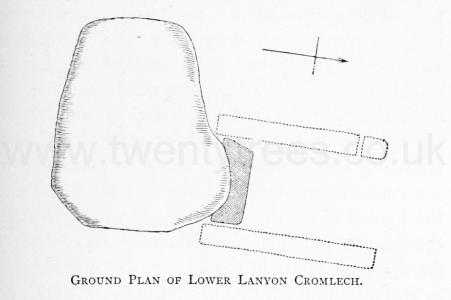
In leaving the, subject of this interesting discovery, and in passing on to other monuments of a like nature, two things must be kept in mind; first, that here the reader has had an instance of a Cromlech actually covered by a mound; and secondly, that the primary interment within the kist consisted of a single body unburnt. These two facts are particularly worth remembering; since in the case of so few other monuments of the kind is anything left but the bare stones themselves to guide the work of elucidating their origin or purpose.
Books, Prehistory, Nænia Cornubiæ by William Borlase Trethevy Cromlech
The largest, though perhaps the least known of the Cornish Cromlechs, is that of Trethevy, Trevethy, or, as the common people call it, Tredavy, in the parish of St. Clere. The earliest account of it is given by Norden, who, writing about the year 1610, says, "Tretheuie, called in Latine Casagigantis, a litle howse raysed of mightie stones, standing on a litle hill within a feilde, the forme hereunder expressed;" and accordingly there follows an original, but highly characteristic engraving of the monument. Two more recent notices of it appear respectively in the Journal of the Royal Institution of Cornwall, and the Report of the Penzance Natural History Society for the year 1850; in the former, the author being S. R. Pattison, Esq., F.G.S., and in the latter, E. H. Pedler, Esq. Of the two drawings here inserted, the first is from a photograph by Mr. Lobb, of Wadebridge, and the second from the accomplished pencil of J. T. Blight, Esq., F.S.A. From these two the reader may easily gather the chief peculiarities of the structure.
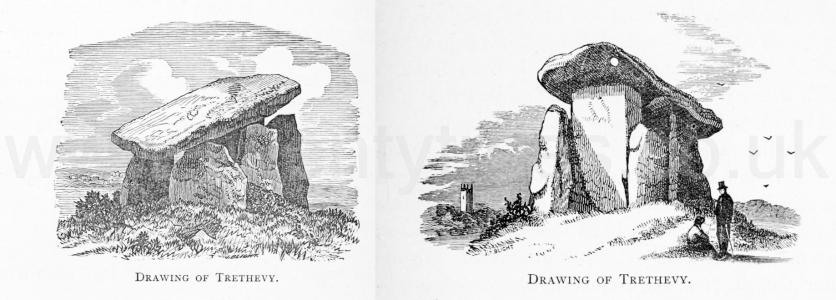
The monument consists of six upright stones, upon the upper edges of three of which, an oblong covering stone is at present diagonally resting. An eighth stone, probably at one time the supporter at the western extremity, has fallen lengthways along the kist, leaving that end open, and throwing the whole burden of supporting the horizontal stone upon two side-stones. These latter have consequently been forced out of the line at their base, and bowed inwards at their top, giving a circular or triagonal form to that end of the kist, seemingly by no means a part of the original plan. According to Mr. Pattison, "the fall of this western pillar caused the superincumbent stone in its descent to break off the upper portions of the side stones nearest to the fallen one, and thus it settled down in its present sloping condition." At its most elevated point the covering stone is thirteen feet from the ground, while at the other end, where it is most depressed, it is only seven-and-a-half. The longest diagonal is from S.W. to N.E., where it measures thirteen feet six; it is nine feet broad, and averages one foot in thickness.
But the most remarkable feature in this Cromlech, as it now stands, is the fine menhir which forms the principal and eastern supporter. In the choice of this stone, as well as in its erection, the greatest care and labour were evidently displayed. On the outer face it presents a smooth surface of finely-grained granite, while the squareness of the upper end, and the well coyned angles, give it almost the appearance of a wrought stone, and make it a most solid and substantial prop. It stands nearly ten feet in height above the small mound in which it is set up; and, to render it the more secure, another and ruder pillar, of nearly an equal height, is projected like a buttress against one side of it. The other four stones, which (two on each side) form the kist, are shorter than the eastern pillar by several feet. The fallen stone, once closing up the western end, seems, however, to have been considerably longer than these side ones; so that it is not improbable that this monument was originally a trilithon1, that is, that the covering stone was supported by two pillars only, one at each end of the grave. The interior of the kist was between nine and ten feet long, and from five feet six to six feet six broad. A pit in the centre shows that the stones rest, not on the mound, but on the natural surface of the ground beneath; so that the pile of earth and stones now lying round them must have been subsequently heaped there, but to what height it is impossible to say.
Note 1. Dr. Furgusson (Rude Stone Monuments, p. ioo,) considers a trilithon, as an "improved dolmen."
There still remain two other features to be noticed in this Cromlech, since they have given rise to a considerable amount of speculation. The first is an aperture in the lower end of the eastern stone, so much resembling an artificially constructed means of access to the chamber, that Norden does not hesitate to call it "the dore or Entrance."1 The height of this "dore" is 2 feet, and its breadth i foot 9 inches. Mr. Pattison considers that it "exhibits marks of art;" but, on an examination of the stone in December, 1871, the author came to the conclusion that the fracture, if not the natural configuration of the stone, might have been accidentally caused either at the time of its transportation from the quarry, or during its erection. The second feature to be noticed is a hole, from six to eight inches in diameter, in the north-east corner of the covering stone. It is more oblong than round, and is placed immediately above the "entrance" just described. The circumstance of a hole being so frequently found in the dolmens of Eastern Europe and India, has induced some antiquaries to form a comparison between them and the Trethevy Stone; but in the former cases the hole is always in one of the side stones, and communicates with the interior of the chamber, while in the latter it is pierced through an overlapping portion of the roof. Norden speaks of it as "an arteficiall holl, which served as it seemeth to putt out a staffe, whereof the house it selfe was not capable." Mr. Pattison confirms this opinion, by mentioning that "the sides are smooth as if worn by a staff;" and such is, without doubt, the true account of it. Another quotation from that gentleman's excellent paper, which, coming from a Fellow of the Geological Society, is of additional interest and value, may be added in conclusion. "The stones," he says, "composing this monument are all of granite, which occurs in boulders about half-a-mile distant. There is a broad upland valley intervening between Trethevy and the granite. The builders must therefore have credit for the exertion of combined strength and skill, in transporting these enormous masses of rock across the hollow, and up the hill on which they now stand."
Note 1. A characteristic example of a dolmen with a rude door, formed by a piece having been cleft out of the lower part of one of the side stones, occurs at Grandmont, Bas-Languedoc, France. A drawing of this will be found in Dr. Furgusson's work, p. 344. Holed dolmens also are found in France, so that the idea in each case may be same.
A dolmen at Arroyolos, in Portugal, is also provided with a door; and instances might be quoted from Palestine and India.
In many cases, it must be remembered, dolmens have served as sheep-pens, and doors may have been cut to afford means of ingress or egress \ though some of the foreign ones certainly do not admit of this solution of the difficulty.
Books, Prehistory, Nænia Cornubiæ by William Borlase Zennor Cromlech
Zennor Quoit, as the Cromlech in the parish of that name is usually called, was, when Borlase wrote his History, the most interesting and perfect specimen of a Kist-Vaen in Western Cornwall. In all probability it had been freshly disinterred from its cairn, or rather the gigantic structure had just succeeded in shaking off, or piercing up through, the crust of loose debris which had been piled over it; for in the middle of the last century, "a stone barrow, fourteen yards in diameter, was heaped round it, and almost reached to the edge of the Quoit."1 Care had been taken, however, in its erection, that no stone should get into the chamber, and it was with great difficulty that a man could squeeze himself into it. Since then, progress and destruction, working together as usual, have much impaired the monu- ment; the cap-stone has been rolled off, and the other stones otherwise damaged by being made to serve as the supports of a cart-shed. Fortunately an original drawing and a plan were made for Dr. Borlase's work, and these the author has been able to reproduce in woodcut from copies of the identical copper-plates then used. They will be found much more accurate and valuable than any sketch of the ruin, as it is at present, could possibly be.
Note 1. The word "Quoit" is here used for the cap-stone only.
The account which accompanies these engravings is as follows: "On the top of a high hill about half-a-mile to the east of Senar Church-town stands a very large handsome Cromlêh; the area inclosed by the supporters is six feet eight inches by four feet, and points east and west. The Kist-Vaen is neatly formed, and fenced every way, and the (Eastern) supporter is 8 feet 10 inches high, from the surface of the earth in the Kist-Vaen, to the under face of the Quoit. The side stones of the Kist-Vaen, run- ning on beyond the end stone, form a little cell to the east, by means of two stones terminating them at right angles. The great depth of this Kist-Vaen, which is about eight feet, at a medium under the plane of the Quoit, is remarkable ...... The Quoit was brought from a karn about a furlong off, which stands a little higher than the spot on which this Cromleh is erected."1
Note 1. Ant. of Cornwall, p. 232, 2nd Edit. "Near this karn is another cromlêh" ('about 200 paces to the N.E. of the first' adds the MS.) "not so large as that here described; in other respects not materially different." Ibid.
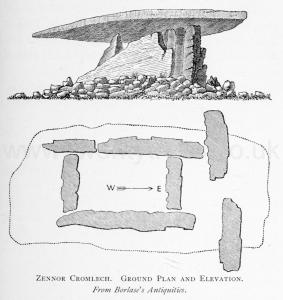

The apparent attempt made in this case to form a second Kist-Vaen is very remarkable. If it really be such, it is a unique instance in Cornwall of what is very commonly found in other Cromlech-bearing countries. It reminds us of those of Northern and Western Wales, and of Anglesea especially, where a small Kist-Vaen, side by side with the larger one, seems to be the rule and not the exception. In all instances, however, that the author has observed, that in the latter district, the smaller Cromlech has its own appropriate covering stone2, while at Zennor both were under one and the same roof. At Loch Maria Ker, in Brittany, and elsewhere in the same country, there seem to be examples much more in point. M. Fremenville observes in reference to one of them "On s'apercoit que 1'interieur etait partage en deux chambres par une cloison composee de deux pierres plantees sur champ. Ces separations se remarquent dans beaucoup d'autres dolmens; plusieurs meme sout divises en trois chambres."1a A drawing of the Cromlech at Loch Maria Ker will be found in Col. Forbes Leslie's Early Races of Scotland, Vol. ii., page 281.
Note 2. Compare the ground plan of Zennor with that of Knockeen, county of Waterford. See Rude Stone Monuments, p. 230.
Note 1a. Fremenville's Antiquites de la Bretagne, Morbihan, p. 23.
It may be noticed that there are remains of ancient hut dwellings at Carne, about a furlong east of the Zennor Cromlech.
Books, Prehistory, Nænia Cornubiæ by William Borlase Chywooner Cromlech
The most perfect and compact Cromlech in Cornwall is now to be described. It is situated on the high ground that extends in a northerly and westerly direction from the remarkable megalithic fortification of Chywoone or Chuun, in the parish of Morvah. The "Quoit" itself, which, seen from a distance, looks much like a mushroom, is distant just 260 paces from the gateway of the castle; and about the same distance on the other side of it, in the tenemerit of Keigwin, is a barrow containing a deep oblong Kist-Vaen, long since rifled, and now buried in furze. Thinking this monument the most worthy of a careful investigation of all the Cromlechs in the neighbourhood, the author proceeded to explore it in the summer of 1871, with a view to determine, if possible, the method and means of erection in the case of such structures in general.
Note 1. Footnote on image. There is a dolmen at Moytura, in Ireland, and another at Halskov, in Scandinavia, the drawings of which would both pass for Chywoone Cromlech.
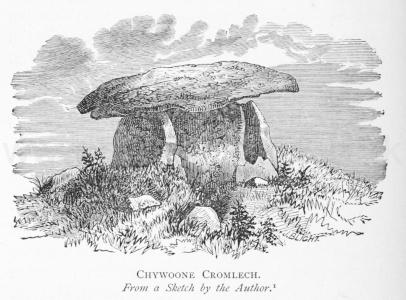
Sinking a pit by the side of the western stone, it was first of all discovered that the building rested on the solid ground, and not on the surrounding tumulus in which it had been subsequently buried. The Kist, as it seems, was formed in the following manner: The two upright stones forming the east and west ends of the chamber were the first to be set up, at a distance of about six feet apart; the breadth of the latter is four feet, and of the former 3 feet 10 inches, while the height of both is as nearly as possible the same, 6 feet 4 inches. Another flat block of granite, 8 feet 4 inches long, was then set up in a slanting position against their northern edges, precisely as one places the third card in building a card box, serving at the same time as a part of the fabric, and as a stay or hold-fast to the sides against which it rests. It was from this side, no doubt, and probably over this slanting stone, that, with the assistance of an embankment and rollers, the cap-stone was raised into its present situation, from which, unlike Humpty Dumpty, in the Nursery Rhyme, not all the adverse combinations of subsequent ages have as yet been able to displace it. This covering stone is a rough slab of hard-grained granite, of a convex shape, and, if the meaning of "vaulted" really enters into the word Cromlech, it would be particularly applicable in this instance. The length across the centre is twelve feet, and the breadth the same, while in thickness it averages from fourteen inches to two feet. The height of the interior of the Kist is seven feet; and a small pit seems to have been sunk in the centre, below the level of the natural soil. It is here that the interment in all probability originally rested, and the chamber was then completed by a fifth stone (7 feet 8 inches long) thrown against the south side, but not reaching sufficiently high to come in contact with the covering stone. The barrow or cairn, which in some places nearly reaches the top of the side stones on the exterior, is thirty-two feet in diameter, and was hedged round by a ring of upright stones. In digging down some of this pile from the sides of the monument, it was discovered that the interstices between the side stones had been carefully protected by smaller ones, placed in such a manner as to make it impossible for any of the rubbish of the mound to find its way into the kist. This arrangement will be better understood by referring to the letters A A in the accompanying plan, and is very suggestive of the whole being once totally buried in the tumulus.
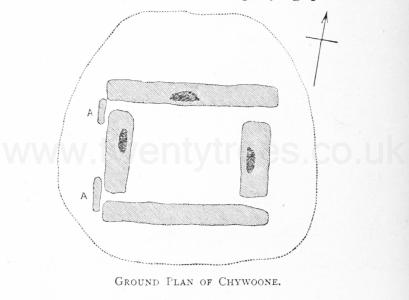
Among the heap of stones a small fractured piece of flint was discovered. Its shape, however, does not lead to the supposition that it was ever used as an instrument of any kind. A round cavity on the capstone seems to have been a work of modern times, and was probably the socket of a pole during the survey.
There are ruins of ancient hut-circles within the enclosure at Chuun Castle, as also at Bossullo Crellas immediately below.
Of the Cornish Cromlechs which remain to be noticed, those at Mulfra and Bosporthennis, in the West, are dismantled; while that at Goss Moor, near St. Columb, is totally destroyed. The largest and more noteworthy of these is the Mulfra Quoit, situated on the summit of the hill of that name, some four miles north-west of" Penzance.
Books, Prehistory, Nænia Cornubiæ by William Borlase Mulfra Cromlech
This monument consists at present of three granite slabs five feet in height, forming the west, north, and east sides of a kist 6 feet 8 inches long, i.e., from east to west, and four feet wide from north to south. On the southern side, instead of the fourth slab, a stone, which is supposed to have been once he covering-stone, rests lengthways and obliquely against the edges of the side stones. This stone, the lower end of which is now fixed in the ground, measured, with "a piece evidently clove or broke off from it," in Borlase's time, 14 feet 3 inches long, by 9 feet 8 inches broad. At that time a stone-barrow, now entirely removed, measuring two feet high, and thirty-seven in diameter, surrounded the monument. There is little doubt that the removal of the southern supporter caused the overthrow of Mulfra Quoit. It might indeed be possible that the cap-stone was never actually raised to the position for which it was intended; but the fact of a fracture having taken place in it, as well as the angle at which it now stands, which is precisely that it would have assumed had it been overbalanced and slipped from its place, presents no analogy to the case of Lower Lanyon, and confirms the supposition that it is simply a fallen Cromlech. The author of the Land's End District states that, he was informed that the date of its collapse was 1752, during a thunderstorm. He was, however, probably misled by an account published in the Philosophical Transactions of the year following, in which it is recorded that a "quoit" on Molfra Hill, (meaning the highest stone on a natural pile of rocks, and often so called by the Cornish), had been struck by lightning in that year. Dr. Borlase visited the spot on the 23rd of October, 1 749, and at that time the Cromlech was in precisely the same state as at present. He says, "As this Quoit is off from its ancient situation with one edge resting on the ground, I thought it might permit us safely to search the enclosed area." Nothing of importance was discovered, and the Doctor only found that a pit had been sunk twenty inches deep in the area of the Kist-Vaen, and "that something which either was originally, or has since turned black, was placed in the bottom of it."
In the winter of 1871, the author caused a low cairn of stones, about thirty feet in diameter, and two feet high, on the northern brow of the hill on which this Cromlech stands, to be dug through. Pieces of charred wood, and a long smooth pebble, the size of a man's finger, was the only product of the exploration. Another barrow lay to the west of this one, but that also appeared to have been previously overhauled.
The ruins of hut circles are to be found on the southern slope of the hill.
Books, Prehistory, Nænia Cornubiæ by William Borlase Quoit near St Columb
The hamlet of Quoit, in the parish of St. Columb Major, is situated at the foot of the gradual acclivity crowned by the circumvallations of Castle-an-dinas, and derives its name from a Cromlech, which, until a year or two since, occupied the corner of a yard adjoining the high road. On the side opposite to Castle-an-dinas stretches away the Goss Moor, "a morisch ground," as Leland well called it, "al baren of woodde." The monument was extant in a dismantled condition until very lately; but a few rough spar stones, split up and ready to carry away, was all that remained of it when the author saw the place in July, 1871. Previous to its fall, it had been used as a goat's house; and, oddly enough, although penned up within it at the time of the collapse, Billy escaped perfectly unharmed.
Old Hals mentions this Cromlech [Map] in his usual brief and inaccurate manner; but fortunately, Mr. Whitaker1 has left a much more full and detailed account. From him we learn that it was "formed of five stones, one covering, three supporting, and one buttressing." The area of the chamber "allowed three or four men to stand upright within it." The side stone on the north was "a spar exactly perpendicular, seven feet in height, and 4 feet 6 inches in width at the middle." That opposite to it, on the south side, was "an iron-stone 6 feet 11 inches high, and 3 feet 7 inches wide in the middle." The eastern slab was also an iron-stone, "7 feet 6 inches in tallness, and 3 feet 3 inches wide at the middle." The covering-stone was of the same nature as the two last, and "lies reclining" from the eastern one along the two others, the declivity being "19 degrees 40 minutes from east to west." "I mention these little circumstances," continues Mr. Whitaker, "to explain clearly a peculiar incident in the construction of the whole; the northern corner of the back-stone appears to have broken off under the weight of the top-stone, as the latter was laid or was settling upon the former; and the top stone now touches not the back-stone in that corner at all, resting only on the other, the southern corner. In consequence of the accident, the whole weight nearly of the top-stone was canted off upon the adjoining side-stone on the right or south; this finding that to press with a force which it was not calculated to bear, began to shrink from its original uprightness, and to lean considerably towards ' the north; it would have leaned very considerably if the eastern edge of it had not lapped over the southern of the back stone, there impinged strongly upon this in its inclination, and been stopped by the resistance which it thus encountered: even with that resistance, it has come to lean no less than 1 6 degrees 30 minutes to the north, or two feet out of the true perpendicular. The whole building, therefore, was in the most imminent hazard of being soon off its poise, and the supporting stones were likely to be crushed to the ground by the covering stone. To prevent this, with the same skill and boldness which could raise such masses upon such supporters; which could also calculate the duration of a structure so warping; and even rest secure enough in their calculations to work under the warping structure, a fifth stone was introduced into it, being thrust in behind the side-stone on the north, as a buttress to the northern edge of the back-stone. 1 A stone was hastily chosen, tapering upwards in form, but about six feet in tallness, a kind of bastard spar, having two legs, a long and a short one, to it; the long leg was pitched in the ground, while the short remains above ground useless; and the body of the stone was then fixed reclining in a sharp angle against the edge of the back-stone, so as to compose a rude kind of powerful arc-boutant to it. Thus buttressed, the back-stone has remained between the supporting and the pressing stones, without any inclination at all to the north; yet, with a projection to the west, the quarter on which it felt no resistance, of 7 degrees 30 minutes, or one foot from the perpendicular. Thus has the structure stood as firm as if no misfortune had befallen it."
Note 1. Cathedral of Cornwall, vol. ii. , p. 76.
At the risk of some tediousness to the reader, this dry, though graphic description of the minutiae of this monument, has been placed before him. In the absence of any drawing or ground plan, it affords all the details they could have furnished, and affords many points of comparison between this and other Cromlechs, both in Cornwall and elsewhere. In its original plan it seems not unlike the Kist-Vaen at Chywoone: the buttress is not an uncommon feature in Cromlechs generally, and has a counterpart in that of Trethevy, described at a previous page.
The several kinds of stone, used in the formation of this "Quoit," are common to the neighbourhood. The Pawton Cromlech, not many miles distant, is composed of a similar sparry stone. In all the other instances, however, granite has been the stone of the district, and therefore has been made use of; while the fact that at Trethevy it was brought from some little distance, seems to afford proof that it was the preferable material, where it was at all within reach.
Whether it be owing to a very extensive population in early times, or to the slow progress of the plough through its rocky and desolate crofts, the parish of Zennor on the northern coast of West Cornwall is a district still particularly fruitful in objects of interest to the Antiquary. One very large Cromlech in this parish has been already noticed, and the author of the "Land's End District" has recorded the existence of another, also "of considerable size," once standing on the estate of Trewey on the opposite hill. Mr. Edmonds also mentions a Kist-Vaen, "six or eight feet square," which, as a farmer informed him, occupied the bottom of a hollow in the centre of a barrow called Gundry Cave, one hundred feet in circumference, raised on the top of a natural "Karn" near the same place. This, like the former one, had been demolished.
Books, Prehistory, Nænia Cornubiæ by William Borlase Bosporthennis Cromlech
There still remains, however, a fourth Cromlech in Zennor parish, the ruins of which are to be found in a small enclosure near the hamlet of Bosporthennis. It is situated in a marshy valley, running down to the sea at Polmear Cove, skirted on the western side by the picturesque granite peaks of Carn Galva. On the slope of this hill, and some four or five hundred yards from the Cromlech, are the ruins of hut circles, strewn in such numbers over the moor, that it is clear they represent the ground plan of a town of considerable size. One of these huts is, perhaps, the best specimen of the beehive type to be found anywhere in England, and in the style of its masonry presents the same megalithic construction which distinguishes the works of the Cromlech-builders. On the cliffs at Bosigran, about half-a-mile distant, are the remains of one of those "cliff castles" so common on the Cornish coasts, and which, doubtless, served in dangerous times as refuges for the persons and effects of the inhabitants of the surrounding villages.
Bosporthennis Cromlech stands at present in the centre of a small mound of stones and earth, which once, no doubt, covered the whole structure. Many smaller mounds occur in the same enclosure, but in one of them, lately explored, nothing remarkable was found; though a farmer asserted that many "cloam"1 pots, and ashes had been taken from barrows on an adjacent hill. The Kist-Vaen in this case is smaller than any of those already noticed, being only five feet in length by three in breadth; and therefore could scarcely have received a body at full length. The height of the side stones is between four and five feet; two of them stand in their original position; one is thrown down, and the fourth has been removed. But the principal feature in this Cromlech, when it was discovered a few years since, was, that it had a circular covering-stone, six inches thick, and five feet in diameter, lying in the area described by the supporters. This was at once pronounced to be unique.
Note 1. "Cloam," a word used by the common people for earthenware. A "cloam buzza," is "an earthenware milk pan" in Cornwall. An eminent philologist, when asked the derivation of the word, at once replied "clay loam."
The fame of the discovery quickly spread. The Local Antiquarianism of the whole neighbourhood was awakened immediately, and savans of all shapes, sexes, and ages, "visited and inspected" the stone. The sphere for conjecture was of course unlimited, and ranged from Arthur's round table, to the circular tombs of modern Bengal. Two things were clear at all events: there were stone-cutters among the Cromlech-builders; and the excellent idea of a circle proved the knowledge of the compass ! But, alas ! the mantle of Edie Ochiltree had fallen this time on a Celt of another family, on a genuine Cornu-Briton ! Edging his way through the crowd which surrounded the monument, until he had reached the front rank, an old man was heard dispelling the fond illusion in the following cruel words: "Now what are 'e all tellin' of? I do mind when uncle Jan, he that was miller down to Polmeor, cum' up 'long to the croft a speering round for a fitty stoan of es mill. And when he had worked 'pon that theere stoan; says he: I'll be jist gone to knack un a bit round like; so he pitched to work; but e would'nt sarve es purpose, so theere 'e es still. And, lor bless yer all, a fine passel o' pepple has been heere for to look 'pon un, but what they sees en un es more than I can tell 'e."
This was "minding the bigging o't" with a vengeance, and the antiquaries could only console themselves in the reflection that the stone must have been of a rudely circular form to have induced the miller to try his tool upon it at all.
When the author saw it in December, 1871, some of the splintered pieces were lying round, and he is led to imagine that the original shape was oblong.
Note. Since the above description of Bosporthennis Cromlech was written, the author accompanied the Rev. W. S. Symonds, F.G.S., to the spot, and caused the floor of the structure to be carefully cleared out. Resting on the natural soil, was found a deposit of burnt bones, some of them adhering to the fragments of a globular vessel. The pottery was of a greenish black colour, not unlike the Upchurch ware, and was half the thickness of the average sepulchral pottery found in Cornwall. A fractured flint, and two stones of the nature of Jasper were found with the bones. These are now in the Museum of Sir W. Jardine, Bart.